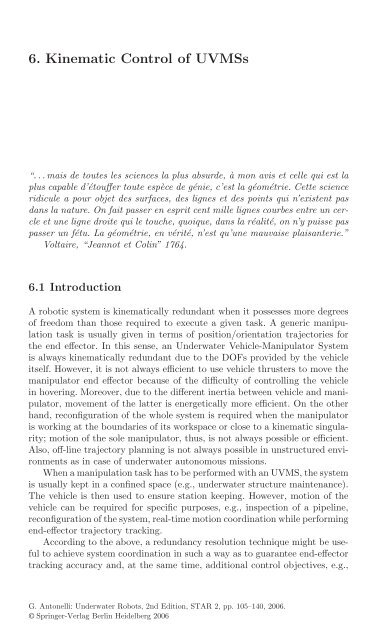Underwater Robots - Gianluca Antonelli.pdf
Underwater Robots - Gianluca Antonelli.pdf
Underwater Robots - Gianluca Antonelli.pdf
You also want an ePaper? Increase the reach of your titles
YUMPU automatically turns print PDFs into web optimized ePapers that Google loves.
6. Kinematic Control of UVMSs<br />
“. ..mais de toutes les sciences la plus absurde, à mon avis et celle qui est la<br />
plus capable d’é touffer toute espè ce de génie, c’est lagé omé trie. Cette science<br />
ridicule apour objet des surfaces, des lignes et des points qui n’existent pas<br />
dans la nature. Onfait passer en esprit cent mille lignes courbes entre uncercle<br />
et une ligne droite qui le touche, quoique, dans la réalité, on n’ypuisse pas<br />
passer un fétu. La géomé trie, en vérité, n’est qu’une mauvaise plaisanterie.”<br />
Voltaire, “Jeannot et Colin” 1764.<br />
6.1 Introduction<br />
Arobotic system is kinematically redundant when it possesses more degrees<br />
of freedom than those required to execute agiven task. Ageneric manipulation<br />
task is usually given in terms of position/orientation trajectories for<br />
the end effector. In this sense, an <strong>Underwater</strong> Vehicle-Manipulator System<br />
is always kinematically redundant due to the DOFs provided by the vehicle<br />
itself. However, it is not always efficient touse vehicle thrusters to move the<br />
manipulator end effector because of the difficulty ofcontrolling the vehicle<br />
in hovering. Moreover, due to the different inertia between vehicle and manipulator,<br />
movement ofthe latter is energetically more efficient. On the other<br />
hand, reconfiguration ofthe whole system is required when the manipulator<br />
is working at the boundaries ofits workspace or close to akinematic singularity;<br />
motion ofthe sole manipulator, thus, is not always possible or efficient.<br />
Also, off-line trajectory planning is not always possible in unstructured environments<br />
asincase of underwater autonomous missions.<br />
Whenamanipulationtask hastobeperformed with an UVMS,the system<br />
is usually kept in aconfined space (e.g., underwater structure maintenance).<br />
The vehicle is then used to ensure station keeping. However, motion of the<br />
vehicle can berequired for specific purposes, e.g., inspection of apipeline,<br />
reconfiguration of the system, real-time motioncoordination whileperforming<br />
end-effector trajectory tracking.<br />
According tothe above, aredundancy resolution technique might beuseful<br />
toachieve system coordination insuch away as to guarantee end-effector<br />
tracking accuracy and, at the same time, additional control objectives, e.g.,<br />
G. <strong>Antonelli</strong>: <strong>Underwater</strong> <strong>Robots</strong>, 2nd Edition, STAR 2, pp. 105–140, 2006.<br />
© Springer-Verlag Berlin Heidelberg 2006






